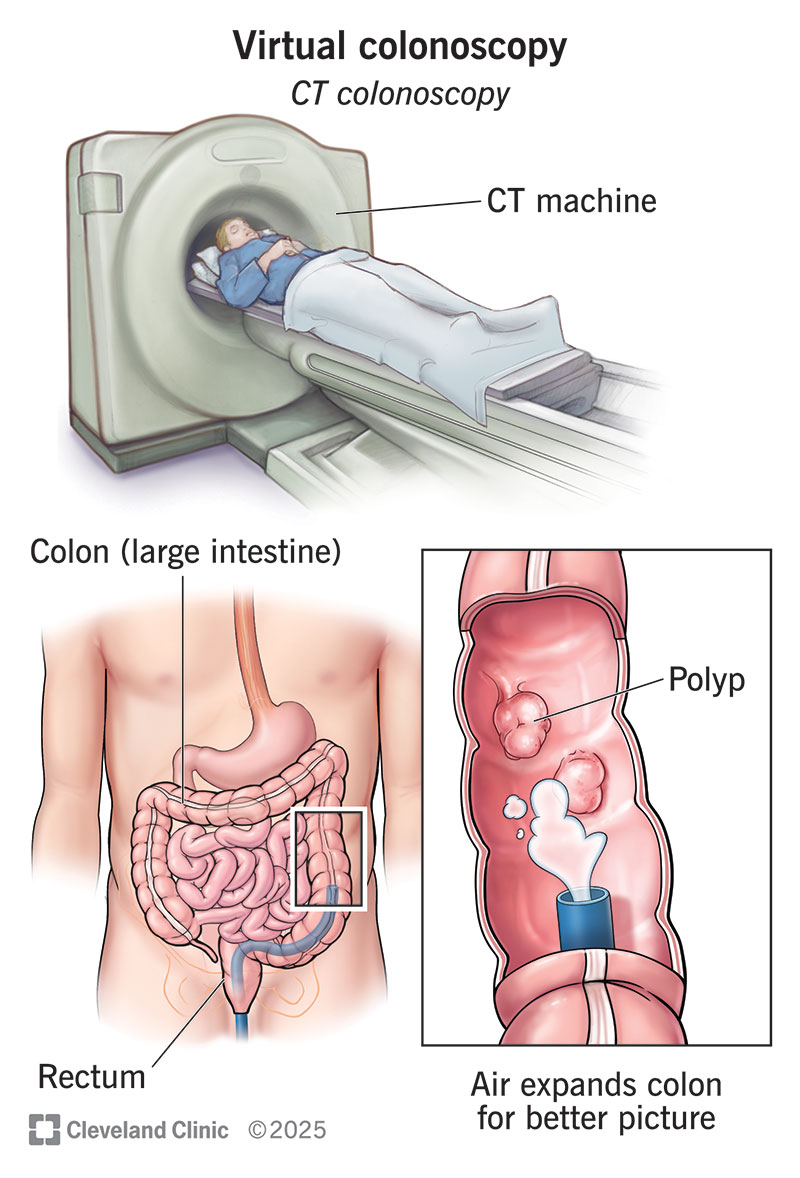A virtual colonoscopy is a CT scan that looks for polyps or cancer in your colon and rectum. This test uses highly detailed 3D images to see the entire length of your colon. The test is about 15 minutes long, and you don’t need sedation.
Advertisement
Cleveland Clinic is a non-profit academic medical center. Advertising on our site helps support our mission. We do not endorse non-Cleveland Clinic products or services. Policy

A virtual colonoscopy (CT colonography) is a noninvasive test that looks for polyps (growths) in your colon. It uses a CT scan and computer technology to take high-quality images of your colon from outside of your body. It gives your healthcare provider a virtual 3D tour, allowing them to see polyps that could eventually progress to colorectal cancer.
Advertisement
Cleveland Clinic is a non-profit academic medical center. Advertising on our site helps support our mission. We do not endorse non-Cleveland Clinic products or services. Policy
It doesn’t require anesthesia and takes only 15 minutes to complete. If your provider sees polyps during the test, you’ll need a traditional colonoscopy to remove them.
Virtual CT colonoscopy is one method healthcare providers use to screen for colon cancer. Experts recommend that everyone get a screening starting at age 45. If you have certain risk factors, you may need one sooner. Your provider can explain if a virtual colonoscopy is the best colon cancer screening choice for you
A virtual colonoscopy uses imaging technology to take detailed pictures of your colon. A technician uses a CT scanner to take several pictures of your abdomen and pelvis. Then, a computer processes these pictures to create 2D and 3D images. A radiologist analyzes these images to look for polyps and other abnormalities in your colon. If found, you’ll need a traditional colonoscopy to remove the polyps.
Before your virtual colonoscopy, you’ll do a bowel preparation, or “prep.” This process empties your colon of all stool (poop), so your provider can see your colon and rectum clearly. You usually do your prep the day before your virtual colonoscopy.
Your provider will give you instructions on how to complete your virtual colonoscopy bowel prep, which may include:
Advertisement
A complete bowel prep is necessary for a successful virtual colonoscopy. It will cause frequent and watery diarrhea, so plan to stay at home and near a bathroom during your prep period.
On the day of your appointment, wear comfortable clothing and don’t wear any jewelry. A healthcare provider will take you to a room with the CT scanner, which looks like a large, donut-shaped machine. Your virtual colonoscopy usually involves these steps:
The test shouldn’t be painful. You may feel pressure in your rectum or like you need to pass gas.
Some of the benefits of a virtual colonoscopy are:
It’s a good option if you can’t have sedation or a traditional colonoscopy for any reason. Because it can take pictures of your entire bowel, it works well if you have a bowel obstruction or narrowed parts in your bowel. It can also show problems in your kidneys, liver or other parts of your abdomen.
Risks and limitations of the test include:
This test may not be safe for everyone. This is why your provider will review your medical history and medications beforehand.
After your virtual colonoscopy, you can go back to your typical activities and eat and drink normally. Because it doesn’t require anesthesia, virtual colonoscopy usually has very little or no recovery time.
Advertisement
You may have some side effects, like excess gas from the air that was pumped into your colon. The gas may cause some cramping or bloating, but this is normal.
If your provider finds an abnormality or a polyp on your virtual colonoscopy, this doesn’t mean you have colorectal cancer. But you’ll need a follow-up colonoscopy so your provider can remove the polyp. Sometimes, they can do the colonoscopy on the same day, as you’re already prepped.
As a virtual colonoscopy gives a wider view of other organs in your pelvis, there’s a chance your provider can see issues outside of your colon. If this happens, they’ll order additional testing on those organs.
If your results are normal, it means your provider didn’t see anything irregular in your colon. Ask your provider when you should have your next colorectal cancer screening. If you have a low risk of colorectal cancer, you may need a repeat virtual colonoscopy every five years.
Several studies show virtual colonoscopy finds large polyps and cancer at about the same rate as a typical colonoscopy. But the accuracy can vary depending on the size of the polyps. It’s generally more accurate in detecting polyps larger than 10 millimeters. It’s slightly less effective at finding polyps less than 6 millimeters.
Advertisement
Seek medical care right away if you notice these symptoms after your virtual colonoscopy:
Colorectal cancer is one of the most common cancers in adults. Colorectal screening tests can catch this cancer early when it’s easier to treat. Still, many people don’t get the screening they need because they don’t want a colonoscopy. With a low risk of complications and a faster recovery, a virtual colonoscopy is a good alternative to traditional colonoscopy. Talk to a healthcare provider about your colorectal screening options to find out if a virtual colonoscopy is right for you.
Advertisement
A colonoscopy or other screening is an important test for colon cancer. The team at Cleveland Clinic can give you peace of mind and expert care when you need it.

Last reviewed on 05/08/2025.
Learn more about the Health Library and our editorial process.